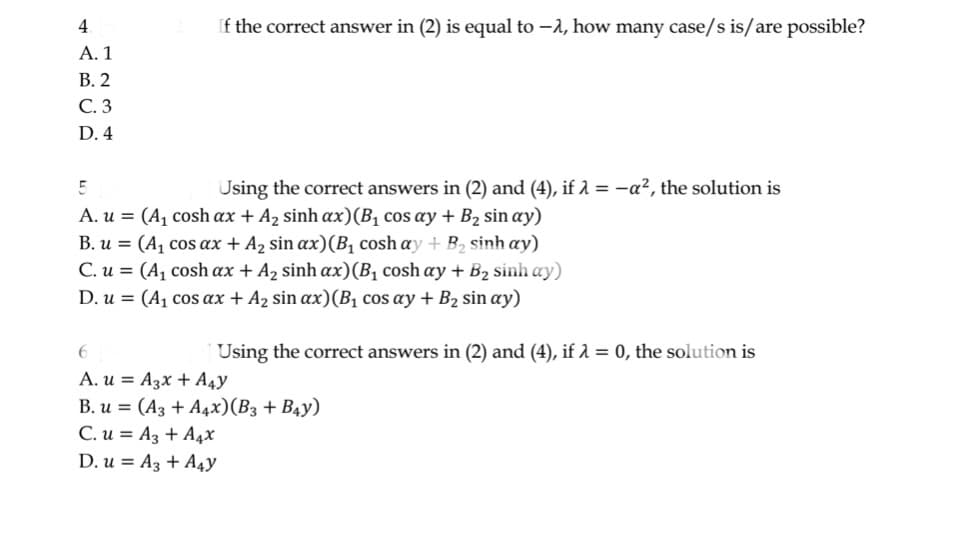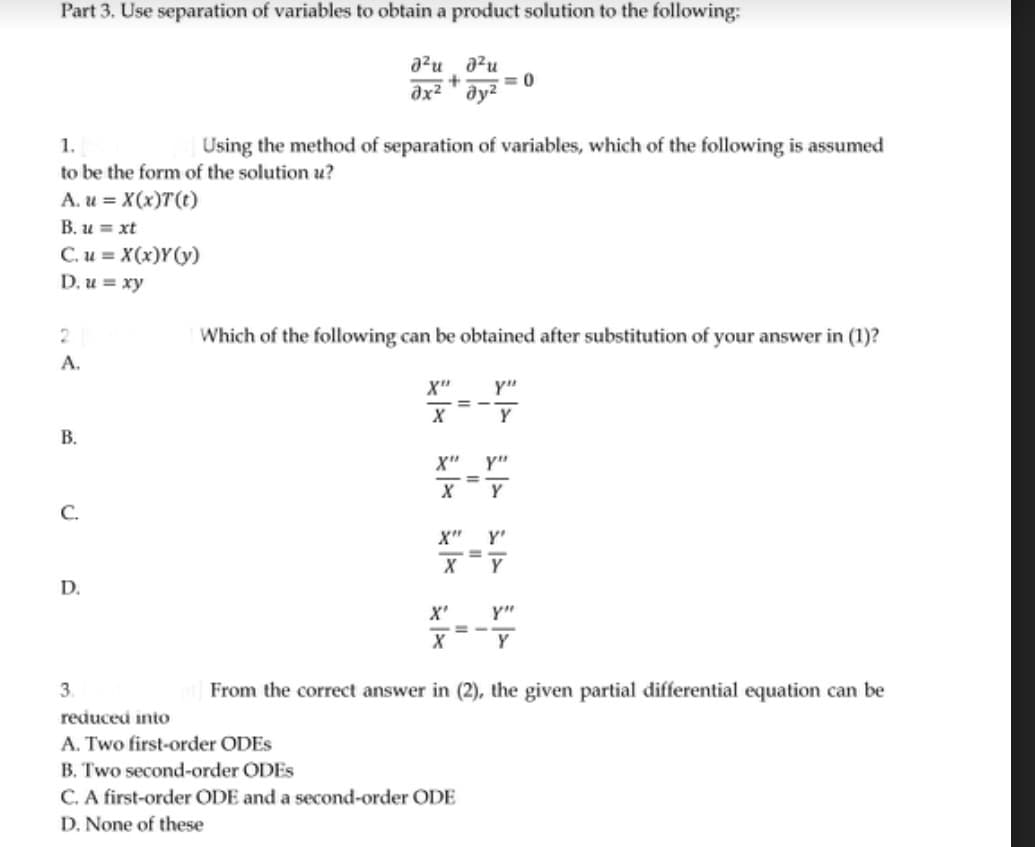Part 3. Use separation of variables to obtain a product solution to the following: d²ud²u + ax² ay² 1. to be the form of the solution u? A. u= X(x)T(t) B. u = xt C. u = X(x)Y(y) D. u = xy A. B. C. D. Using the method of separation of variables, which of the following is assumed Which of the following can be obtained after substitution of your answer in (1)? 11 11 3. reduced into A. Two first-order ODES B. Two second-order ODES C. A first-order ODE and a second-order ODE D. None of these Y" Y y" Y X=- 0 X" Y" *-* X Y Y" Y From the correct answer in (2), the given partial differential equation can be
Part 3. Use separation of variables to obtain a product solution to the following: d²ud²u + ax² ay² 1. to be the form of the solution u? A. u= X(x)T(t) B. u = xt C. u = X(x)Y(y) D. u = xy A. B. C. D. Using the method of separation of variables, which of the following is assumed Which of the following can be obtained after substitution of your answer in (1)? 11 11 3. reduced into A. Two first-order ODES B. Two second-order ODES C. A first-order ODE and a second-order ODE D. None of these Y" Y y" Y X=- 0 X" Y" *-* X Y Y" Y From the correct answer in (2), the given partial differential equation can be
Algebra & Trigonometry with Analytic Geometry
13th Edition
ISBN:9781133382119
Author:Swokowski
Publisher:Swokowski
Chapter7: Analytic Trigonometry
Section7.2: Trigonometric Equations
Problem 75E
Related questions
Question
Answer 3 Only

Transcribed Image Text:4
A. 1
B.2
C. 3
D. 4
If the correct answer in (2) is equal to -, how many case/s is/are possible?
5
Using the correct answers in (2) and (4), if λ = -a², the solution is
A. u = (A₁ cosh ax + A₂ sinh ax) (B₁ cos ay + B₂ sin ay)
B. u = (A₁ cos ax + A₂ sin ax) (B₁ cosh ay + B₂ sinh ay)
C. u = (A1 cosh ax + A, sinh ax)(B, cosh ay + B2 sinh ay)
D. u = (A₁ cos ax + A₂ sin ax) (B₁ cos ay + B₂ sin ay)
Using the correct answers in (2) and (4), if λ = 0, the solution is
6
A. u
A3x + A4Y
B. u (A3 + A4x) (B3 + B4Y)
=
C. u= A3 + A4x
D. u A3 + A4y

Transcribed Image Text:Part 3. Use separation of variables to obtain a product solution to the following:
²ud²u
+
əx² ay²
1.
to be the form of the solution u?
A. u = X(x)T(t)
B. u = xt
C. u = X(x)Y(y)
D. u = xy
2
A.
B.
C.
D.
Using the method of separation of variables, which of the following is assumed
Which of the following can be obtained after substitution of your answer in (1)?
*****
3.
reduced into
A. Two first-order ODES
B. Two second-order ODES
= 0
X" Y"
Y
X
=
Y"
Y
Y'
X=Y
C. A first-order ODE and a second-order ODE
D. None of these
From the correct answer in (2), the given partial differential equation can be
Y"
Y
Expert Solution
This question has been solved!
Explore an expertly crafted, step-by-step solution for a thorough understanding of key concepts.
Step by step
Solved in 5 steps

Recommended textbooks for you

Algebra & Trigonometry with Analytic Geometry
Algebra
ISBN:
9781133382119
Author:
Swokowski
Publisher:
Cengage

Linear Algebra: A Modern Introduction
Algebra
ISBN:
9781285463247
Author:
David Poole
Publisher:
Cengage Learning

Algebra & Trigonometry with Analytic Geometry
Algebra
ISBN:
9781133382119
Author:
Swokowski
Publisher:
Cengage

Linear Algebra: A Modern Introduction
Algebra
ISBN:
9781285463247
Author:
David Poole
Publisher:
Cengage Learning